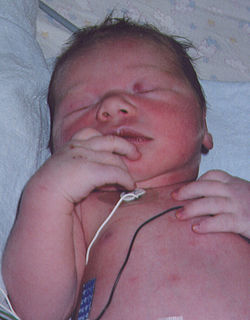Central cyanosis
From WikiLectures
Central cyanosis is a type of cyanosis characterized by bluish mucous membranes, the acres are warm. It is caused by insufficient saturation of arterial blood with oxygen. It manifests itself when the absolute amount of reduced hemoglobin in the flowing blood rises above 50 g/l. [1] With anemia , the manifestations of cyanosis are milder, with polyglobulia, on the contrary, they are more pronounced.
Causes[edit | edit source]
- Heart defects with right-to-left shunt;
- insufficient oxygenation of blood in the lungs (eg RDS , persistent fetal circulation , severe pneumonia , COPD );
- hypoventilation ( intracranial hemorrhage , sepsis , chest injury);
- the presence of a significant amount of abnormal hemoglobin, which prevents the transfer of oxygen ( methemoglobin , etc.).
Oxygen test[edit | edit source]
It is used to determine the cause of central cyanosis in newborns .
- We let the newborn breathe 100% oxygen for 10 minutes with a well-sealed mask. If oxygen tension (saturation) does not increase => right-left shunt. If saturation increases => lung involvement.
Cyanosis of only the lower half of the body[edit | edit source]
- It occurs in a heart defect with a right-to-left shunt through an open ductus arteriosus (e.g. preductal coarctation of the aorta ).
Cyanosis of only the upper half of the body[edit | edit source]
- It is caused by an isolated uncorrected transposition of the great arteries with an open ductus arteriosus (short circuit of oxygenated blood from the pulmonary artery to the descending aorta).
Links[edit | edit source]
Related articles[edit | edit source]
Reference[edit | edit source]
- ↑ LEBL, Jan – PROVAZNÍK, Kamil – HEJCMANOVÁ, Ludmila. Preklinická pediatrie. 2. edition. Galén, 2007. ISBN 978-80-7262-438-6.

